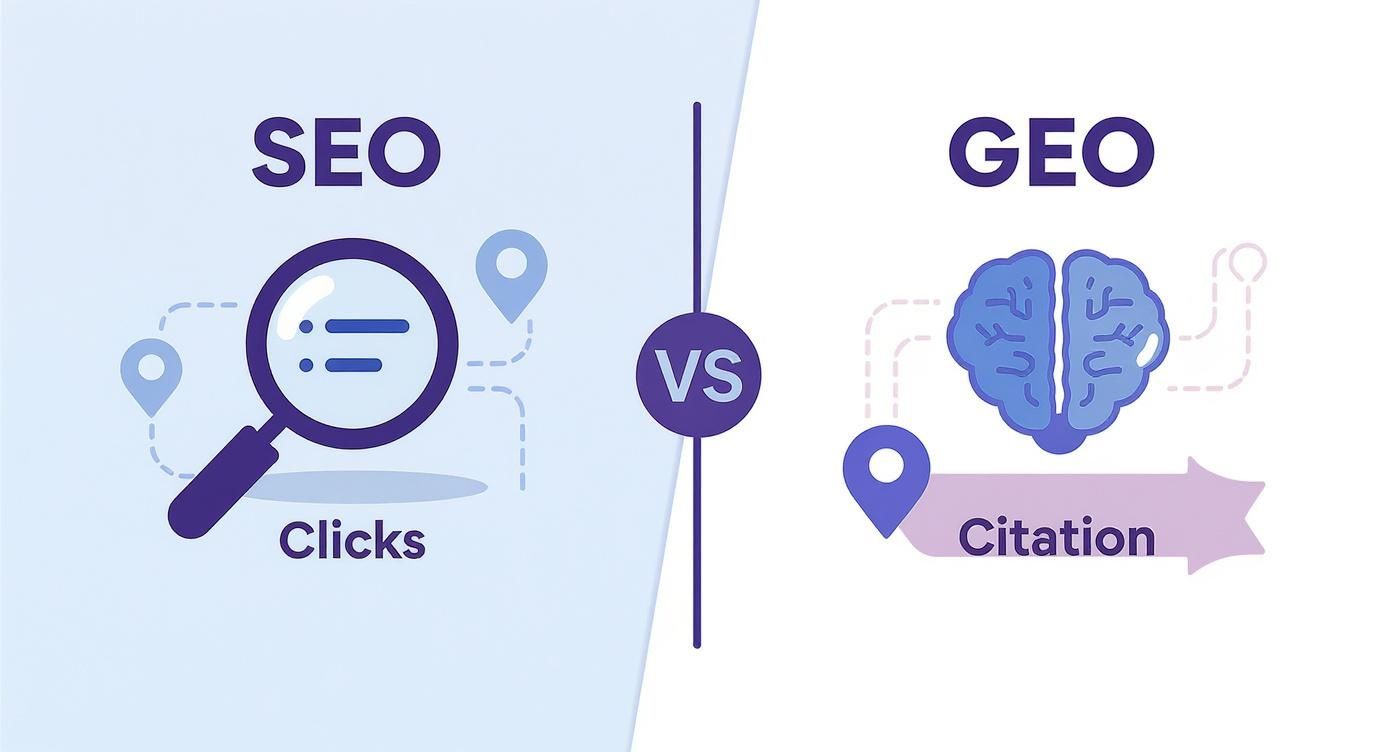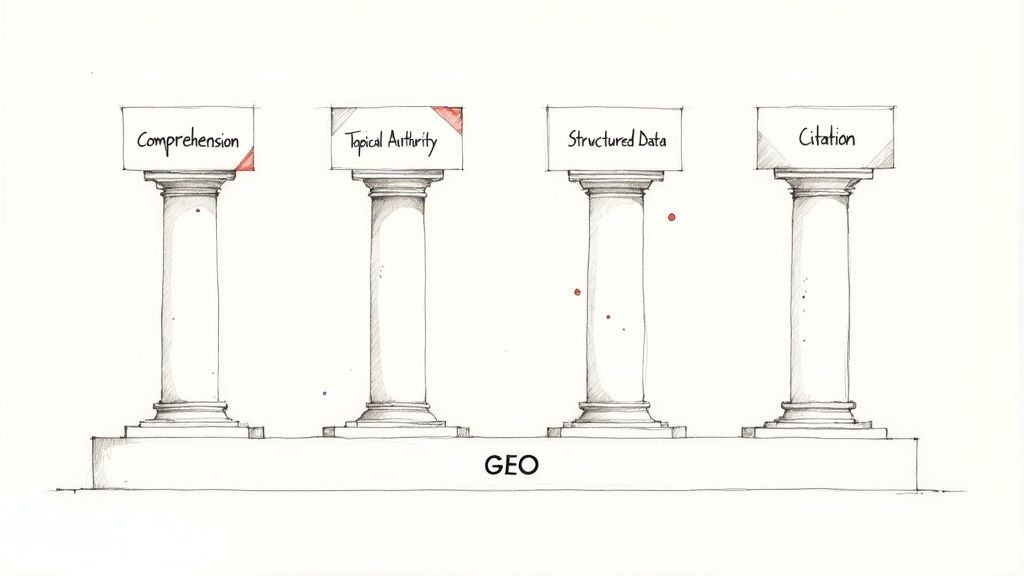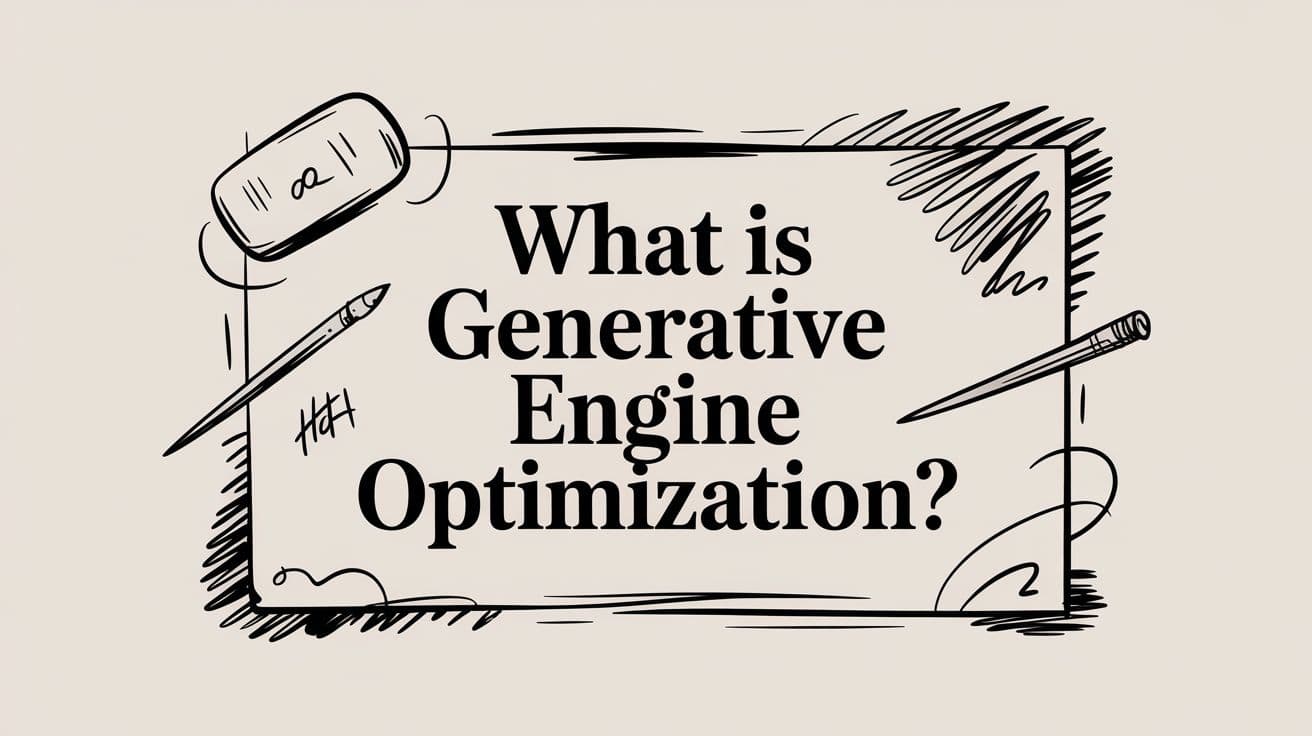Generative Engine Optimization (GEO) is a content strategy designed to make your brand the trusted, citable source for AI answer engines like Google’s AI Overviews and ChatGPT.
While traditional SEO fights for clicks from a list of links, GEO’s goal is different.
The mission is to get your content, data, and brand name embedded directly inside the AI-generated answer.
It’s the new front line for digital visibility. While most marketers are still chasing blue links, GEO focuses on becoming the answer itself.
The Big Shift: From Clicks to Direct Citations
For years, the digital marketing playbook was simple: rank #1 on Google, get the click, and drive traffic to your website. But generative AI is rewriting that playbook. The new challenge isn’t just ranking—it’s becoming the trusted source for the AI.
Generative Engine Optimization is less about climbing a search results page and more about embedding your expertise into the direct answers people receive.
Here’s a clear way to see the difference:
- Traditional SEO is like writing a book and hoping someone finds it on a library shelf.
- Generative Engine Optimization is being the expert quoted in a definitive research paper that everyone cites.
Your audience is no longer just a person with a question. It's also the machine learning model synthesizing information to give that person an answer.
Why You Can't Ignore This Shift
This isn't a trend on the horizon; it’s happening now and scaling fast. Google's AI Overviews are already appearing for millions of users, fundamentally changing the SERP.
This means a huge slice of your audience is already getting answers from an AI. If your content isn’t optimized for this reality, you are on the fast track to becoming invisible.
The core of GEO is a move from visibility to authority. Instead of just being seen, the goal is to be believed and cited. Your brand becomes the embedded source for a topic—a much more defensible position than a temporary #1 ranking.
How GEO Builds on Top of SEO
Many think GEO throws out everything we know about SEO. That's wrong.
GEO doesn’t replace SEO; it builds directly on it. A strong SEO foundation is the price of entry. Things like technical site health, high-quality content, and clear E-E-A-T (Experience, Expertise, Authoritativeness, Trustworthiness) signals are non-negotiable.
AI engines, just like Google's traditional crawlers, are far more likely to trust and pull information from sites that are already seen as credible.
But GEO requires a laser focus on what machines need to understand information. This means structuring content for easy parsing, answering questions directly, and backing up claims with data. This approach is a close cousin to Answer Engine Optimization, which focuses on providing concise answers to user queries.
Winning in this new era means mastering both disciplines. You need the technical chops of SEO combined with the content precision of GEO.
To make the distinction clear, let's break down how these two disciplines stack up.
Traditional SEO vs. Generative Engine Optimization
| Aspect | Traditional SEO (Search Engine Optimization) | GEO (Generative Engine Optimization) |
|---|---|---|
| Primary Goal | Rank high in a list of search results to earn a click. | Get cited directly within an AI-generated answer. |
| Key Metric | Keyword rankings, organic traffic, click-through rate (CTR). | Citation frequency, visibility score in AI, brand mentions. |
| Core Tactic | On-page optimization, backlink building, keyword targeting. | Structured data, clear sourcing, statistical evidence, direct answers. |
| Audience | Primarily human searchers scanning a list of links. | Both human users and the AI models that serve them. |
| Success Looks Like | Your website appears as a #1 "blue link" on Google. | Your brand's data or quote is part of the AI's direct answer. |
SEO gets people to your front door. GEO gets you quoted in the definitive guide. You need both to thrive in the age of AI search.
How AI Engines Actually Find and Use Your Content
To win at GEO, you have to understand how the machine thinks. AI answer engines don't just "Google" something and return the top link. They act like a research assistant, pulling information from multiple places to construct a new, synthesized answer.
They don’t just find information; they reconstruct it. This process pulls from three main sources, and your content needs to be a star player in each one.
The Three Information Sources AI Engines Use
- Initial Training Data: This is the foundation. Picture a massive, static snapshot of the internet taken at a specific point in time. It's a colossal library of websites, books, and articles that forms the AI's core understanding of topics and concepts. If your content wasn't part of this initial training set, you're starting from behind.
- Proprietary Knowledge Graphs: This is the AI's structured brain—an interconnected database of facts and entities. Think of it as a supercharged Wikipedia that knows "Apple" is a company run by Tim Cook and a fruit. For your brand to get picked, it needs to be a clear entity in these knowledge graphs.
- Real-Time Information Retrieval: This is how AI engines stay current. When a question demands up-to-the-minute info, the model runs live web searches to grab the latest data from trusted sources. This is your biggest opportunity to get new content cited.
The key takeaway? AI models synthesize. They cross-reference their static training data with structured knowledge and fresh web results to build a trusted, composite answer. Your content must be so clear and authoritative that it becomes a reliable building block.
Machine Readability Trumps Everything
A human can skim a messy blog post and pull out the main idea. An AI cannot. For your content to be selected, it needs to be exceptionally clear, well-organized, and structured for a machine.
This screenshot from Google shows how complex their ranking systems are—systems AI models also rely on to determine which sources are high-quality.

As the image shows, ranking involves understanding meaning, relevance, quality, and context. These are all signals your content has to provide for an AI to understand it.
To do this, your content must be optimized for machine comprehension. This means using factual language, implementing structured data like Schema markup to add context, and building a strong profile of citations. An AI needs you to connect the dots for it.
This is exactly why a solid foundation in technical SEO best practices is non-negotiable; it ensures your site is accessible and easy for both crawlers and AI agents to understand.
The Four Pillars of a Winning GEO Strategy
Moving from theory to practice means building your GEO strategy on solid ground. A successful approach is built on four core pillars. Each one addresses a specific need of an AI model, helping it understand, trust, and ultimately cite your content.

Think of these pillars as the foundation for every piece of content you create. Mastering them is how you become an authority in the age of AI.
Pillar 1: Write for Machine Comprehension
The first pillar is the most fundamental: write for machine comprehension, not just human readability. AI models don't infer intent the way people do. They need information presented in a logical and unambiguous way.
This means your content must directly answer specific questions with extreme clarity. Don't just cover a topic broadly; break it down into its core components and address each one explicitly. This is a crucial part of any modern content optimization for SEO workflow.
Here’s how to put this into practice:
- Use question-based headings. Instead of "Our Product Features," use "What Problems Does Our Product Solve?"
- Write short, declarative sentences. One idea per sentence is the rule. This crushes ambiguity.
- Define key terms clearly. Don't assume the AI understands your industry jargon. Spell it out.
Pillar 2: Build Deep Topical Authority
AI models are designed to find the most authoritative source on a topic. Topical authority isn't built with one article; it's proven through a deep, interconnected web of content. Standalone blog posts no longer cut it.
You need to create content clusters that cover a subject from every angle. This signals to an AI that your expertise is comprehensive.
An AI is more likely to cite a source that has 25 detailed articles on project management than one that has a single viral post on the topic. Depth and interconnectedness are direct signals of expertise.
For instance, a company selling CRM software shouldn't just write "What is a CRM?" They need a cluster of content covering:
- "How to Choose a CRM for Small Businesses"
- "Comparing CRM Pricing Models"
- "Integrating Your CRM with Marketing Automation"
Each piece needs to link to others within the cluster, creating a dense network of knowledge that establishes your site as the definitive resource.
Pillar 3: Implement Precise Structured Data
The third pillar is technical but critical. Structured data, or Schema markup, is the language you use to speak directly to machines. It's metadata you add to your site's code that explains your content in a format AI engines can instantly understand.
Without it, an AI has to guess the context. With it, you're handing the AI a labeled diagram.
Here are the most important types for GEO:
- FAQ Schema: Marks up questions and their answers, making them perfect for AI to pull into responses.
- How-To Schema: Breaks down a process into a clear, step-by-step sequence that machines can repurpose.
- Article Schema: Provides context like the author and publication date—all key E-E-A-T signals.
Implementing structured data removes the guesswork and makes your content far more likely to be used as a source.
Pillar 4: Provide Verifiable Citations and Sourcing
The final pillar is about trust. AI models are trained to value credibility, and one of the strongest signals of trust is how you handle sources and citations. This works in two directions.
First, your content needs to be cited by other reputable websites. These are modern "votes of confidence" that tell an AI your information is trustworthy.
Second, you must rigorously cite your own sources. When you state a fact or statistic, link out to the original study or report. For example, citing a credible source like the Pew Research Center for a statistic shows your claims are grounded in evidence—a trait highly valued by AI models built to provide accurate information.
Real-World Examples of GEO in Action
Theory is one thing, but seeing how Generative Engine Optimization actually works makes the concept click. The goal is to answer a user's question before they even finish asking, with the AI acting as your delivery person.
Let's walk through two realistic examples.
Case Study 1: The E-commerce Retailer
Imagine an online store selling high-end coffee makers. In the old SEO world, they'd target "best espresso machine under $500." They'd write a blog post, build some backlinks, and hope to land on page one.
With a GEO mindset, the strategy gets more precise.
Instead of chasing a broad keyword, they aim to become the definitive source for using their products. They take the product page for the "AeroPress Pro" and build out a massive, detailed FAQ section. They answer hyper-specific user prompts:
- What is the optimal grind size for the AeroPress Pro?
- How do you clean the AeroPress Pro filter?
- Can you make a latte with the AeroPress Pro?
Each question-and-answer pair gets marked up with FAQ Schema. This is like whispering in the AI's ear, "Hey, here is a specific question and its authoritative answer."
The objective shifts from getting a click to being the citation. When a user asks an AI, "What grind size should I use for my AeroPress Pro?" the goal is for the AI to pull the answer straight from the retailer's product page and credit them as the source.
Case Study 2: The B2B SaaS Company
Now, consider a B2B SaaS company selling project management software. Their audience is trying to solve complex workflow problems. The company's goal is to become the go-to resource for team productivity.
Their GEO strategy centers on a cornerstone guide: "How to Improve Team Efficiency by 25%."
To make this content citable, they do a few things differently:
- Bring Original Data: They include stats from a proprietary survey of 500 customers, showing how specific features led to a 15% reduction in missed deadlines. AI models prioritize unique, hard data.
- Use Actionable Headings: Instead of vague subheadings, they use headers that mirror real user prompts, like "How to Prioritize Tasks with the Eisenhower Matrix" or "What Are the Best Practices for Running a Weekly Sprint Meeting?"
- Structure for Synthesis: The content is broken down into clean, numbered lists and bullet points. This makes it incredibly easy for an AI to pull out specific methods.
The result? When a manager asks an AI, "What are some data-backed methods for improving team efficiency?" the SaaS company's specific strategies and original data are primed to be featured in the answer, complete with a direct citation.
The Future of Search and Your Place In It
Generative Engine Optimization is more than a new acronym; it signals a tectonic shift in how people find information. The era of the "zero-click search" is accelerating as AI models deliver direct answers instead of a list of links.
This is a fundamental change in user behavior that redefines what it means to be visible online.
For businesses, this demands a strategic pivot. The old goal was to drive clicks. The new goal is to build enough authority to become a trusted source within the AI ecosystem itself.
From Clicks to Citations: A New Definition of Success
If the game has changed, the scorecard must change with it. Obsessing over traditional rankings is like measuring a radio ad's success by newspaper sales. The metrics are from a different era.
Instead, marketers need to track KPIs that reflect influence in AI conversations.
- Brand Mentions: How often is your brand named as a solution in an AI response?
- AI Citations: Is your content being directly sourced and credited in AI answers?
- Share of Voice: What percentage of answers on a key topic feature your insights versus your competitors'?
Ignoring this shift is a massive strategic risk. The future of search is being rewritten by generative AI, and staying on top of developments like the evolving landscape of Google's generative AI, Gemini, and speech-to-text integration is no longer optional.
Being the cited source is the new #1 ranking. It’s a move from being on the shelf to being the expert the AI quotes. This position is far more defensible than a temporary top spot on a search results page.
The Urgency for Early Adoption
This is happening much faster than most people realize. Early adoption offers a huge competitive advantage. While your competitors are still pouring all their resources into chasing keyword rankings, you can be busy establishing your brand as a foundational source of truth for AI models.
This creates a protective moat that gets harder for others to cross as AI ecosystems mature.
A Practical Shift in Strategy
So, what does this mean for your day-to-day marketing? It means a deliberate focus on creating content that is not only helpful for humans but also easily digestible and verifiable for machines. You have to improve your AI search visibility by making your content structured, authoritative, and citable.
Your content needs to become an asset for the AI.
Ultimately, your place in this new world comes down to a choice. You can keep optimizing for a reality that's fading, or you can start building authority for the one that's emerging right now. The businesses that thrive will be those that focus on becoming the most trusted voice in their field, one AI citation at a time.
Your Action Plan for Getting Started with GEO
Theory is great, but results come from action. Getting started with generative engine optimization doesn't mean throwing out your SEO playbook. It means making smart, deliberate moves to gain an edge.
Here are four concrete steps you can take today.

Think of this as making small, focused adjustments that build a massive advantage over time.
1. Find the Questions Your Customers Actually Ask
First, stop obsessing over keywords and start collecting questions. AI engines are built to deliver direct answers to real-world problems. Get into the weeds of your customer data to find the exact language people use.
- Dig into your support tickets and sales calls. What are the top 5-10 questions your team answers every single day?
- Use tools like AnswerThePublic. Find long-tail, conversational queries that signal real user intent.
- Talk to your customers. Ask them: "If you were to ask an AI for help with [the problem you solve], what would you type?"
Do this right, and you’ll have a list of high-intent questions directly tied to revenue.
2. Audit and Rework Your Top Content
Next, take your best-performing blog posts and view them through a GEO lens. The mission is to turn them into unimpeachable sources an AI would be crazy not to cite. Your goal is to make your answers the clearest and most citable on the web.
Break down dense paragraphs into scannable lists, add data-backed stats, and restructure broad topics into a direct Q&A format. If you want to go deeper, our guide on preparing your SEO for AI has you covered.
3. Lay the Foundation with Structured Data
Structured data (Schema markup) is your secret weapon for talking to machines. It cuts through ambiguity and tells AI models exactly what your content is about.
Think of Schema as adding subtitles to a movie for someone who speaks a different language. It’s one of the highest-impact GEO moves you can make because it ensures nothing gets lost in translation.
You don't need to go overboard. Start by adding these two types to your most important pages:
- Article Schema: Defines the basics like the author, publication date, and headline.
- FAQ Schema: Explicitly marks up question-and-answer pairs, making them incredibly easy for an AI to grab.
4. Start Tracking Your AI Mentions
Finally, shift how you measure success. In the world of GEO, the game isn't just about clicks. The new KPI is citations. You need to know how often your brand gets mentioned in AI responses.
This is where a tool like AI SEO Tracker becomes essential. It lets you monitor your visibility across different large language models, showing you where you’re winning and where your competitors are getting cited instead of you. This data is the feedback loop that will steer your entire GEO strategy.
Common Questions About Generative Engine Optimization
As GEO picks up steam, smart marketers are asking the right questions. It’s a new frontier, so it's natural to wonder how this fits with what you're already doing. Let's tackle the most common questions head-on.
So, Is Traditional SEO Dead?
Not a chance. In fact, it’s more important than ever. Think of traditional SEO as the foundation of a house. Technical health, quality backlinks, and great content are the non-negotiable prerequisites for any AI engine to consider your site a trustworthy source.
GEO is the strategic layer you build on top of that solid foundation. It's not a replacement. You cannot win at GEO if your SEO fundamentals are not rock-solid.
How Do You Measure the ROI of GEO?
This is where the mindset has to shift. We're moving from just tracking rankings and traffic toward measuring brand visibility and influence within AI conversations.
Instead of obsessing over keyword positions, the new key metrics are about how often your brand is cited in AI answers, the referral traffic from those mentions, and follow-up direct searches for your brand. Sharp brand monitoring and digging into referral data are the best ways to connect an AI mention to a business outcome.
Is This Only for Big Companies?
Absolutely not. If anything, GEO is a massive opportunity for smaller, specialized businesses. Niche businesses can gain a significant competitive edge with GEO.
By going deep and establishing undeniable topical authority in a very specific area, a smaller site can become the go-to source for AI on that subject. This is how a focused business can outmaneuver larger, generalist competitors who are a mile wide and an inch deep. For small businesses, GEO is the ultimate way to punch above your weight.
Ready to see where your brand stands in the world of AI search? The AI SEO Tracker platform shows you exactly where you're being cited across major language models like ChatGPT and Gemini. Stop guessing and start measuring your AI search visibility. Find out how you stack up today.

